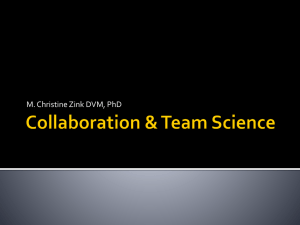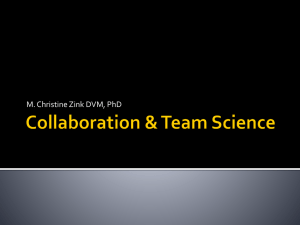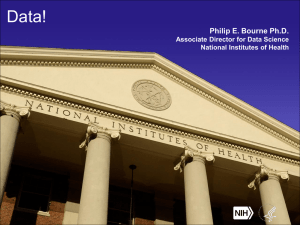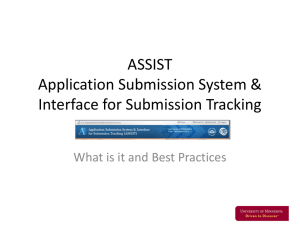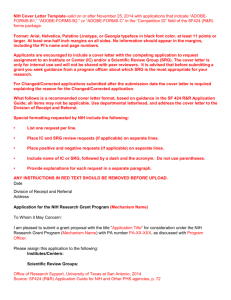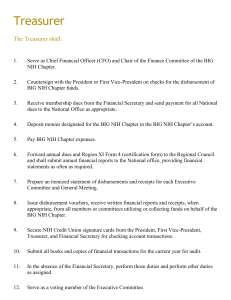Research Opportunities in Obstetric Fistula-R01
advertisement
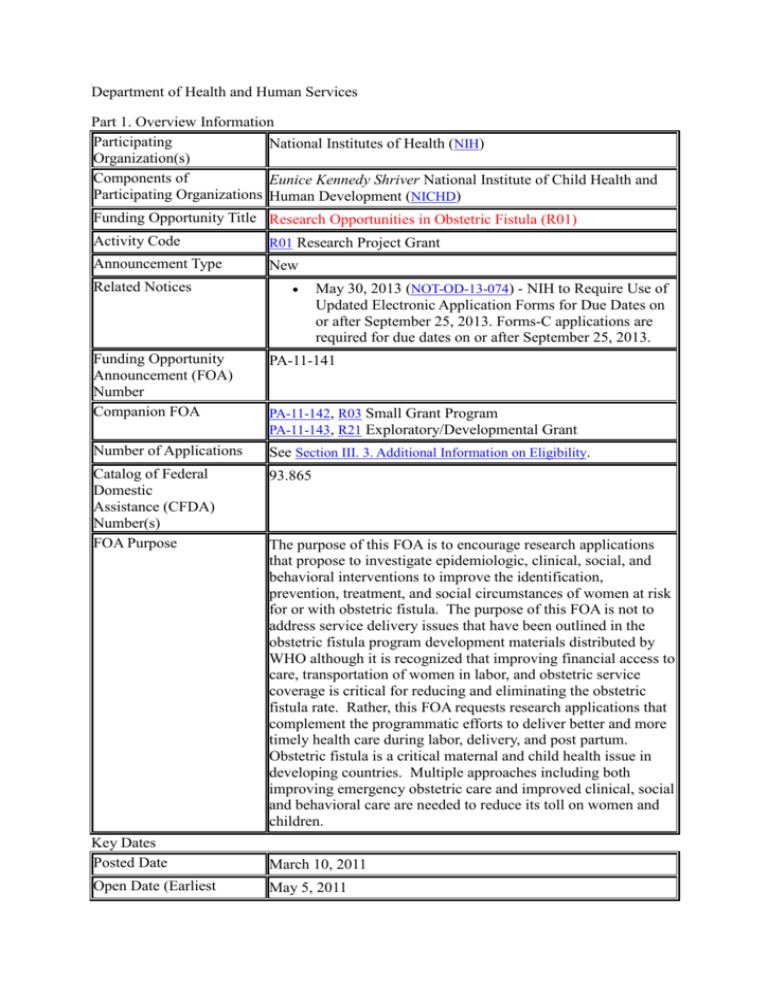
Department of Health and Human Services Part 1. Overview Information Participating National Institutes of Health (NIH) Organization(s) Components of Eunice Kennedy Shriver National Institute of Child Health and Participating Organizations Human Development (NICHD) Funding Opportunity Title Research Opportunities in Obstetric Fistula (R01) Activity Code R01 Research Project Grant Announcement Type New Related Notices May 30, 2013 (NOT-OD-13-074) - NIH to Require Use of Updated Electronic Application Forms for Due Dates on or after September 25, 2013. Forms-C applications are required for due dates on or after September 25, 2013. Funding Opportunity Announcement (FOA) Number Companion FOA PA-11-141 Number of Applications See Section III. 3. Additional Information on Eligibility. Catalog of Federal Domestic Assistance (CFDA) Number(s) FOA Purpose 93.865 PA-11-142, R03 Small Grant Program PA-11-143, R21 Exploratory/Developmental Grant The purpose of this FOA is to encourage research applications that propose to investigate epidemiologic, clinical, social, and behavioral interventions to improve the identification, prevention, treatment, and social circumstances of women at risk for or with obstetric fistula. The purpose of this FOA is not to address service delivery issues that have been outlined in the obstetric fistula program development materials distributed by WHO although it is recognized that improving financial access to care, transportation of women in labor, and obstetric service coverage is critical for reducing and eliminating the obstetric fistula rate. Rather, this FOA requests research applications that complement the programmatic efforts to deliver better and more timely health care during labor, delivery, and post partum. Obstetric fistula is a critical maternal and child health issue in developing countries. Multiple approaches including both improving emergency obstetric care and improved clinical, social and behavioral care are needed to reduce its toll on women and children. Key Dates Posted Date March 10, 2011 Open Date (Earliest May 5, 2011 Submission Date) Letter of Intent Due Date May 5, 2011 Application Due Date(s) Standard dates apply, by 5:00 PM local time of applicant organization. AIDS Application Due Date(s) Scientific Merit Review Not Applicable Standard dates apply Advisory Council Review Standard dates apply Earliest Start Date(s) Standard dates apply Expiration Date May 8, 2014 Due Dates for E.O. 12372 Not Applicable Required Application Instructions It is critical that applicants follow the instructions in the SF 424 (R&R) Application Guide except where instructed to do otherwise (in this FOA or in a Notice from the NIH Guide for Grants and Contracts). Conformance to all requirements (both in the Application Guide and the FOA) is required and strictly enforced. Applicants must read and follow all application instructions in the Application Guide as well as any program-specific instructions noted in Section IV. When the program-specific instructions deviate from those in the Application Guide, follow the program-specific instructions. Applications that do not comply with these instructions may be delayed or not accepted for review. A compatible version of Adobe Reader is required for download. For Assistance downloading this or any Grants.gov application package, please contact Grants.gov Customer Support at http://www07.grants.gov/contactus/contactus.jsp. Table of Contents Part 1. Overview Information Part 2. Full Text of the Announcement Section I. Funding Opportunity Description Section II. Award Information Section III. Eligibility Information Section IV. Application and Submission Information Section V. Application Review Information Section VI. Award Administration Information Section VII. Agency Contacts Section VIII. Other Information Part 2. Full Text of Announcement Section I. Funding Opportunity Description Background The United Nations Millennium Development Goals (MDG) include eight goals that all 191 UN member states have agreed to try to achieve by the year 2015. The United Nations Millennium Declaration, signed in September 2000 commits world leaders to combat poverty, hunger, disease, illiteracy, environmental degradation, and discrimination against women. The MDGs are derived from this Declaration, and all have specific targets and indicators. The fifth MDG sets to improve maternal health by reducing maternal mortality and achieving universal access to reproductive health because improved maternal health is recognized as an important factor in reducing poverty and illiteracy. Maternal mortality is a pervasive problem and much worse in the developing world; more than one-half million women die worldwide in childbirth each year. The most common causes of maternal mortality include hemorrhage, sepsis, hypertensive disorders, and obstructed labor. Obstructed labor is a consequence of social practices that lead to early marriage and childbearing, of lack of access to skilled birth attendants and hospital obstetric services, and lack of transportation to services. Consequences of labor that is obstructed or prolonged can include, among other conditions, maternal death, fetal death, and obstetric fistula (OF). OF is a result of the prolonged pressure of the presenting fetal part on the pelvis over days of labor. The constant pressure interferes with blood flow and eventually results in tissue necrosis leading to fistulae most commonly between the bladder and the vagina or additionally to a fistula between the rectum and the vagina. Complicated cases can involve both types of fistulae. Every year about 100,000 women are affected by OF and there are approximately 2 million cases worldwide of women living with fistulae that have not been repaired. Because urine and feces leak out uncontrollably, these women, often very young, are ostracized from their villages and families without good survival strategies. OF is also treatable by surgery, although access is usually limited. Even after surgery, however, reintroduction of the women to the family and village can be difficult. A recent scientific presentation reported that 90 % of the babies born in cases of OF were stillborn. Additionally, the primary surgical repair success rate was about 70%, secondary about 60% and tertiary about 55%. Program efforts in developing countries have been lead by the World Health Organization, which has developed documents to guide developing countries in the programmatic aspects of reducing OF. Short, medium and long term goals should include health promotion and awareness and the provision of high quality basic and comprehensive maternal health services for all. These national programs should also provide skilled professional to repair fistulae. These issues are closely linked to ensuring that women have reproductive rights recognized by policies and regulations which in the end, will lead to the achievement of the MDG goals. Recognizing that health care delivery is a critical component to reducing OF, this FOA proposes complimentary scientific investigations to improve the knowledge base, reduce complications and improve outcomes from surgical repairs, and to develop social and behavioral programs to positively develop family and village reactions to women who have or have had OF. Although some risk factors are known, the epidemiology of the population at risk is not clearly delineated. Known risk factors include service delivery issues such as delay in transport and lack of operating room availability. Traditional practices of vaginal cutting in labor and female genital mutilation as well as young age and first pregnancy are also well identified factors. Beyond these factors, questions remain about identification of women at risk for whom preventive clinical measures could prevent fistulae formation. Clinical treatment is addressed differentially in different settings and can include or not include such elements as antibiotics and fluid management. The evidence base for risk factor identification and improving surgical and social outcomes needs expansion through scientific study. Research Objectives The purpose of this FOA is not to address service delivery issues that have been outlined in the obstetric fistula program development materials distributed by WHO, although it is recognized that improving financial access to care, transportation of women in labor, and obstetric service coverage is critical for reducing and eliminating the obstetric fistula rate. Rather, this FOA requests research applications that complement the programmatic efforts and investigate epidemiologic, clinical, social, and behavioral interventions to improve the identification, prevention, treatment, and social circumstances of women at risk for or with obstetric fistula. Examples of research projects could include: Epidemiology A complete epidemiologic study, preferably prospective, to identify subgroups either at the facility or community level who are at risk for OF. Potentially this could include other pelvic floors disorders related to obstructed or prolonged labor in women of reproductive age. Epidemiologic studies could also focus on identification of risk factors for surgical failures. Clinical For primary prevention, are there conservative measures that can reduce the incidence of fistula formation in women who presented with obstructed labor? For example, this could be at the community level or facility level and could include use of fluids or antibiotics or catheters. Studies investigating use of antibiotics which could include type of medication, length of administration, and timing of administration. Studies investigating optimum timing of fistula repair; Level 1 evidence from randomized clinical trials is preferred when possible. Behavioral/Social Research on reintroduction of women with repaired fistulae back into their home environment. Studies investigating social change to improve the lives of women with fistulae that have not been repaired. Identification of barriers to reproductive health services and novel social approaches to delay childbearing for primary prevention. Research projects must compliment any local ongoing programs in emergency obstetric care. Incorporation of sustainable approaches to interventions will be positively considered. Priority will be given to projects in areas in the developing world with the highest rates of maternal mortality and obstetric fistula, such as sub-Saharan Africa. Section II. Award Information Funding Instrument Grant Application Types Allowed New Renewal Resubmission Revisions The OER Glossary and the SF 424 (R&R) Application Guide provide details on these application types. Funds Available and Anticipated Number of Awards The number of awards is contingent upon NIH appropriations, and the submission of a sufficient number of meritorious applications. Award Budget Application budgets are not limited, but need to reflect actual needs of the proposed project. Award Project Period The scope of the proposed project should determine the project period. The maximum period is 5 years. NIH grants policies as described in the NIH Grants Policy Statement will apply to the applications submitted and awards made in response to this FOA. Section III. Eligibility Information 1. Eligible Applicants Eligible Organizations Higher Education Institutions: Public/State Controlled Institutions of Higher Education Private Institutions of Higher Education The following types of Higher Education Institutions are always encouraged to apply for NIH support as Public or Private Institutions of Higher Education: Hispanic-serving Institutions Historically Black Colleges and Universities (HBCUs) Tribally Controlled Colleges and Universities (TCCUs) Alaska Native and Native Hawaiian Serving Institutions Nonprofits Other Than Institutions of Higher Education Nonprofits with 501(c)(3) IRS Status (Other than Institutions of Higher Education) Nonprofits without 501(c)(3) IRS Status (Other than Institutions of Higher Education) For profit Organizations Small Businesses For-Profit Organizations (Other than Small Businesses) Governments State Governments County Governments City or Township Governments Special District Governments Indian/Native American Tribal Governments (Federally Recognized) Indian/Native American Tribal Governments (Other than Federally Recognized) Eligible Agencies of the Federal Government U.S. Territory or Possession Other Independent School Districts Public Housing Authorities/Indian Housing Authorities Native American tribal organizations (other than Federally recognized tribal governments) Faith-based or Community-based Organizations Regional Organizations Non-domestic (non-U.S.) Entities (Foreign Organizations) Foreign (non-U.S.) components of U.S. Organizations are allowed. Required Registrations Applicant organizations must complete the following registrations as described in the SF 424 (R&R) Application Guide to be eligible to apply for or receive an award. Applicants must have a valid Dun and Bradstreet Universal Numbering System (DUNS) number in order to begin each of the following registrations. Central Contractor Registration (CCR) – must maintain an active registration, to be renewed at least annually Grants.gov eRA Commons All Program Directors/Principal Investigators (PD/PIs) must also work with their institutional officials to register with the eRA Commons or ensure their existing eRA Commons account is affiliated with the eRA Commons account of the applicant organization. All registrations must be completed by the application due date. Applicant organizations are strongly encouraged to start the registration process at least four (4) weeks prior to the application due date. Eligible Individuals (Project Director/Principal Investigator) Any individual(s) with the skills, knowledge, and resources necessary to carry out the proposed research as the Project Director/Principal Investigator (PD/PI) is invited to work with his/her organization to develop an application for support. Individuals from underrepresented racial and ethnic groups as well as individuals with disabilities are always encouraged to apply for NIH support. For institutions/organizations proposing multiple PDs/PIs, visit the Multiple Program Director/Principal Investigator Policy and submission details in the Senior/Key Person Profile (Expanded) Component of the SF 424 (R&R) Application Guide. 2. Cost Sharing This FOA does not require cost sharing as defined in the NIH Grants Policy Statement. 3. Additional Information on Eligibility Number of Applications Applicant organizations may submit more than one application, provided that each application is scientifically distinct. NIH will not accept any application in response to this FOA that is essentially the same as one currently pending initial peer review unless the applicant withdraws the pending application. NIH will not accept any application that is essentially the same as one already reviewed. Resubmission applications may be submitted, according to the NIH Policy on Resubmission Applications from the SF 424 (R&R) Application Guide. Section IV. Application and Submission Information 1. Requesting an Application Package Applicants must download the SF424 (R&R) application package associated with this funding opportunity using the “Apply for Grant Electronically” button in this FOA or following the directions provided at Grants.gov. 2. Content and Form of Application Submission It is critical that applicants follow the instructions in the SF424 (R&R) Application Guide, except where instructed in this funding opportunity announcement to do otherwise. Conformance to the requirements in the Application Guide is required and strictly enforced. Applications that are out of compliance with these instructions may be delayed or not accepted for review. Letter of Intent Although a letter of intent is not required, is not binding, and does not enter into the review of a subsequent application, the information that it contains allows IC staff to estimate the potential review workload and plan the review. By the date listed in Part 1. Overview Information, prospective applicants are asked to submit a letter of intent that includes the following information: Descriptive title of proposed research Name, address, and telephone number of the PD(s)/PI(s) Names of other key personnel Participating institutions Number and title of this funding opportunity The letter of intent should be sent to: Susan F. Meikle, M.D., M.S.P.H. Program Director, Pelvic Floor Disorders Contraception and Reproductive Health Branch, Center for Population Research The Eunice Kennedy Shriver National Institute of Child Health and Human Development (NICHD), National Institutes of Health (NIH) 6100 Executive Boulevard, Suite 8B13 Bethesda, MD 20892 (Rockville, MD 20852 for courier or non-USPS service) Telephone: (301) 273-8541 FAX: (301)480-1972 Email: meikles@mail.nih.gov Required and Optional Components The forms package associated with this FOA includes all applicable components, mandatory and optional. Please note that some components marked optional in the application package are required for application submission. Follow all instructions in the SF424 (R&R) Application Guide to ensure you complete all appropriate “optional” components. Page Limitations All page limitations described in the SF424 Application Guide and the Table of Page Limits must be followed. PHS 398 Research Plan Component All instructions in the SF424 (R&R) Application Guide must be followed, with the following additional instructions:. Resource Sharing Plan Individuals are required to comply with the instructions for the Resource Sharing Plans (Data Sharing Plan, Sharing Model Organisms, and Genome Wide Association Studies (GWAS) as provided in the SF424 (R&R) Application Guide. Appendix Do not use the appendix to circumvent page limits. Follow all instructions for the Appendix as described in the SF424 (R&R) Application Guide, Foreign Organizations Foreign (non-US) organizations must follow policies described in the NIH Grants Policy Statement, and procedures for foreign organizations described throughout the SF424 (R&R) Application Guide. 3. Submission Dates and Times Part I. Overview Information contains information about Key Dates. Applicants are encouraged to submit in advance of the deadline to ensure they have time to make any application corrections that might be necessary for successful submission. Organizations must submit applications via Grants.gov, the online portal to find and apply for grants across all Federal agencies. Applicants must then complete the submission process by tracking the status of the application in the eRA Commons, NIH’s electronic system for grants administration. Applicants are responsible for viewing their application in the eRA Commons to ensure accurate and successful submission. Information on the submission process and a definition of on-time submission are provided in the SF424 (R&R) Application Guide. 4. Intergovernmental Review (E.O. 12372) This initiative is not subject to intergovernmental review. 5. Funding Restrictions All NIH awards are subject to the terms and conditions, cost principles, and other considerations described in the NIH Grants Policy Statement. Pre-award costs are allowable only as described in the NIH Grants Policy Statement. 6. Other Submission Requirements and Information Applications must be submitted electronically following the instructions described in the SF 424 (R&R) Application Guide. Paper applications will not be accepted. Applicants must complete all required registrations before the application due date. Section III. Eligibility Information contains information about registration. For assistance with your electronic application or for more information on the electronic submission process, visit Applying Electronically. Important reminders: All PD/PIs must include their eRA Commons ID in the Credential field of the Senior/Key Person Profile Component of the SF 424(R&R) Application Package. Failure to register in the Commons and to include a valid PD/PI Commons ID in the credential field will prevent the successful submission of an electronic application to NIH. The applicant organization must ensure that the DUNS number it provides on the application is the same number used in the organization’s profile in the eRA Commons and for the Central Contractor Registration (CCR). Additional information may be found in the SF424 (R&R) Application Guide. See more tips for avoiding common errors. Upon receipt, applications will be evaluated for completeness by the Center for Scientific Review, NIH. Applications that are incomplete will not be reviewed. Post Submission Materials Applicants are required to follow the instructions for post-submission materials, as described in NOT-OD-10-115. Section V. Application Review Information 1. Criteria Only the review criteria described below will be considered in the review process. As part of the NIH mission, all applications submitted to the NIH in support of biomedical and behavioral research are evaluated for scientific and technical merit through the NIH peer review system. Overall Impact Reviewers will provide an overall impact/priority score to reflect their assessment of the likelihood for the project to exert a sustained, powerful influence on the research field(s) involved, in consideration of the following review criteria and additional review criteria (as applicable for the project proposed). Scored Review Criteria Reviewers will consider each of the review criteria below in the determination of scientific merit, and give a separate score for each. An application does not need to be strong in all categories to be judged likely to have major scientific impact. For example, a project that by its nature is not innovative may be essential to advance a field. Significance Does the project address an important problem or a critical barrier to progress in the field? If the aims of the project are achieved, how will scientific knowledge, technical capability, and/or clinical practice be improved? How will successful completion of the aims change the concepts, methods, technologies, treatments, services, or preventative interventions that drive this field? Investigator(s) Are the PD/PIs, collaborators, and other researchers well suited to the project? If Early Stage Investigators or New Investigators, or in the early stages of independent careers, do they have appropriate experience and training? If established, have they demonstrated an ongoing record of accomplishments that have advanced their field(s)? If the project is collaborative or multiPD/PI, do the investigators have complementary and integrated expertise; are their leadership approach, governance and organizational structure appropriate for the project? Innovation Does the application challenge and seek to shift current research or clinical practice paradigms by utilizing novel theoretical concepts, approaches or methodologies, instrumentation, or interventions? Are the concepts, approaches or methodologies, instrumentation, or interventions novel to one field of research or novel in a broad sense? Is a refinement, improvement, or new application of theoretical concepts, approaches or methodologies, instrumentation, or interventions proposed? Approach Are the overall strategy, methodology, and analyses well-reasoned and appropriate to accomplish the specific aims of the project? Are potential problems, alternative strategies, and benchmarks for success presented? If the project is in the early stages of development, will the strategy establish feasibility and will particularly risky aspects be managed? If the project involves clinical research, are the plans for 1) protection of human subjects from research risks, and 2) inclusion of minorities and members of both sexes/genders, as well as the inclusion of children, justified in terms of the scientific goals and research strategy proposed? Environment Will the scientific environment in which the work will be done contribute to the probability of success? Are the institutional support, equipment and other physical resources available to the investigators adequate for the project proposed? Will the project benefit from unique features of the scientific environment, subject populations, or collaborative arrangements? Additional Review Criteria As applicable for the project proposed, reviewers will evaluate the following additional items while determining scientific and technical merit, and in providing an overall impact/priority score, but will not give separate scores for these items. Protections for Human Subjects For research that involves human subjects but does not involve one of the six categories of research that are exempt under 45 CFR Part 46, the committee will evaluate the justification for involvement of human subjects and the proposed protections from research risk relating to their participation according to the following five review criteria: 1) risk to subjects, 2) adequacy of protection against risks, 3) potential benefits to the subjects and others, 4) importance of the knowledge to be gained, and 5) data and safety monitoring for clinical trials. For research that involves human subjects and meets the criteria for one or more of the six categories of research that are exempt under 45 CFR Part 46, the committee will evaluate: 1) the justification for the exemption, 2) human subjects involvement and characteristics, and 3) sources of materials. For additional information on review of the Human Subjects section, please refer to the Human Subjects Protection and Inclusion Guidelines. Inclusion of Women, Minorities, and Children When the proposed project involves clinical research, the committee will evaluate the proposed plans for inclusion of minorities and members of both genders, as well as the inclusion of children. For additional information on review of the Inclusion section, please refer to the Human Subjects Protection and Inclusion Guidelines. Vertebrate Animals The committee will evaluate the involvement of live vertebrate animals as part of the scientific assessment according to the following five points: 1) proposed use of the animals, and species, strains, ages, sex, and numbers to be used; 2) justifications for the use of animals and for the appropriateness of the species and numbers proposed; 3) adequacy of veterinary care; 4) procedures for limiting discomfort, distress, pain and injury to that which is unavoidable in the conduct of scientifically sound research including the use of analgesic, anesthetic, and tranquilizing drugs and/or comfortable restraining devices; and 5) methods of euthanasia and reason for selection if not consistent with the AVMA Guidelines on Euthanasia. For additional information on review of the Vertebrate Animals section, please refer to the Worksheet for Review of the Vertebrate Animal Section. Biohazards Reviewers will assess whether materials or procedures proposed are potentially hazardous to research personnel and/or the environment, and if needed, determine whether adequate protection is proposed. Resubmissions For Resubmissions, the committee will evaluate the application as now presented, taking into consideration the responses to comments from the previous scientific review group and changes made to the project. Renewals For Renewals, the committee will consider the progress made in the last funding period. Revisions For Revisions, the committee will consider the appropriateness of the proposed expansion of the scope of the project. If the Revision application relates to a specific line of investigation presented in the original application that was not recommended for approval by the committee, then the committee will consider whether the responses to comments from the previous scientific review group are adequate and whether substantial changes are clearly evident. Additional Review Considerations As applicable for the project proposed, reviewers will consider each of the following items, but will not give scores for these items, and should not consider them in providing an overall impact/priority score. Applications from Foreign Organizations Reviewers will assess whether the project presents special opportunities for furthering research programs through the use of unusual talent, resources, populations, or environmental conditions that exist in other countries and either are not readily available in the United States or augment existing U.S. resources. Select Agent Research Reviewers will assess the information provided in this section of the application, including 1) the Select Agent(s) to be used in the proposed research, 2) the registration status of all entities where Select Agent(s) will be used, 3) the procedures that will be used to monitor possession use and transfer of Select Agent(s), and 4) plans for appropriate biosafety, biocontainment, and security of the Select Agent(s). Resource Sharing Plans Reviewers will comment on whether the following Resource Sharing Plans, or the rationale for not sharing the following types of resources, are reasonable: 1) Data Sharing Plan; 2) Sharing Model Organisms; and 3) Genome Wide Association Studies (GWAS). Budget and Period of Support Reviewers will consider whether the budget and the requested period of support are fully justified and reasonable in relation to the proposed research. 2. Review and Selection Process Applications will be evaluated for scientific and technical merit by (an) appropriate Scientific Review Group(s) (assignments will be shown in the eRA Commons), in accordance with NIH peer review policy and procedures, using the stated review criteria. As part of the scientific peer review, all applications: May undergo a selection process in which only those applications deemed to have the highest scientific and technical merit (generally the top half of applications under review), will be discussed and assigned an overall impact/priority score. Will receive a written critique. Applications will be assigned on the basis of established PHS referral guidelines to the appropriate NIH Institute or Center. Applications will compete for available funds with all other recommended applications. Following initial peer review, recommended applications will receive a second level of review by the appropriate advisory council or board. The following will be considered in making funding decisions: Scientific and technical merit of the proposed project as determined by scientific peer review. Availability of funds. Relevance of the proposed project to program priorities. 3. Anticipated Announcement and Award Dates After the peer review of the application is completed, the PD/PI will be able to access his or her Summary Statement (written critique) via the eRA Commons. Information regarding the disposition of applications is available in the NIH Grants Policy Statement. Section VI. Award Administration Information 1. Award Notices If the application is under consideration for funding, NIH will request "just-in-time" information from the applicant as described in the NIH Grants Policy Statement. A formal notification in the form of a Notice of Award (NoA) will be provided to the applicant organization for successful applications. The NoA signed by the grants management officer is the authorizing document and will be sent via email to the grantee business official. Awardees must comply with any funding restrictions described in Section IV.5. Funding Restrictions. Selection of an application for award is not an authorization to begin performance. Any costs incurred before receipt of the NoA are at the recipient's risk. These costs may be reimbursed only to the extent considered allowable pre-award costs. Any application awarded in response to this FOA will be subject to the DUNS, CCR Registration, and Transparency Act requirements as noted on the Award Conditions and Information for NIH Grants website. 2. Administrative and National Policy Requirements All NIH grant and cooperative agreement awards include the NIH Grants Policy Statement as part of the NoA. For these terms of award, see the NIH Grants Policy Statement Part II: Terms and Conditions of NIH Grant Awards, Subpart A: General and Part II: Terms and Conditions of NIH Grant Awards, Subpart B: Terms and Conditions for Specific Types of Grants, Grantees, and Activities. More information is provided at Award Conditions and Information for NIH Grants. Cooperative Agreement Terms and Conditions of Award Not Applicable 3. Reporting When multiple years are involved, awardees will be required to submit the Non-Competing Continuation Grant Progress Report (PHS 2590) annually and financial statements as required in the NIH Grants Policy Statement. A final progress report, invention statement, and Financial Status Report are required when an award is relinquished when a recipient changes institutions or when an award is terminated. The Federal Funding Accountability and Transparency Act of 2006 (Transparency Act), includes a requirement for awardees of Federal grants to report information about first-tier subawards and executive compensation under Federal assistance awards issued in FY2011 or later. All awardees of applicable NIH grants and cooperative agreements are required to report to the Federal Subaward Reporting System (FSRS) available at www.fsrs.gov on all subawards over $25,000. See the NIH Grants Policy Statement for additional information on this reporting requirement. Section VII. Agency Contacts We encourage inquiries concerning this funding opportunity and welcome the opportunity to answer questions from potential applicants. Application Submission Contacts Grants.gov Customer Support (Questions regarding Grants.gov registration and submission, downloading or navigating forms) Contact Center Phone: 800-518-4726 Email: support@grants.gov GrantsInfo (Questions regarding application instructions and process, finding NIH grant resources) Telephone 301-435-0714 TTY 301-451-5936 Email: GrantsInfo@nih.gov eRA Commons Help Desk(Questions regarding eRA Commons registration, tracking application status, post submission issues) Phone: 301-402-7469 or 866-504-9552 (Toll Free) TTY: 301-451-5939 Email: commons@od.nih.gov Scientific/Research Contact(s) Susan F. Meikle, M.D., M.S.P.H. Eunice Kennedy Shriver National Institute of Child Health and Human Development (NICHD) Telephone: 301- 273-8541 Email: meikles@mail.nih.gov Peer Review Contact(s) Examine your eRA Commons account for review assignment and contact information (information appears two weeks after the submission due date). Financial/Grants Management Contact(s) Bryan S. Clark, M.B.A. Eunice Kennedy Shriver National Institute of Child Health and Human Development (NICHD) Telephone: 301-435-6975 Email: clarkb1@mail.nih.gov Section VIII. Other Information Recently issued trans-NIH policy notices may affect your application submission. A full list of policy notices published by NIH is provided in the NIH Guide for Grants and Contracts. All awards are subject to the terms and conditions, cost principles, and other considerations described in the NIH Grants Policy Statement. Authority and Regulations Awards are made under the authorization of Sections 301 and 405 of the Public Health Service Act as amended (42 USC 241 and 284) and under Federal Regulations 42 CFR Part 52 and 45 CFR Parts 74 and 92. Weekly TOC for this Announcement NIH Funding Opportunities and Notices

